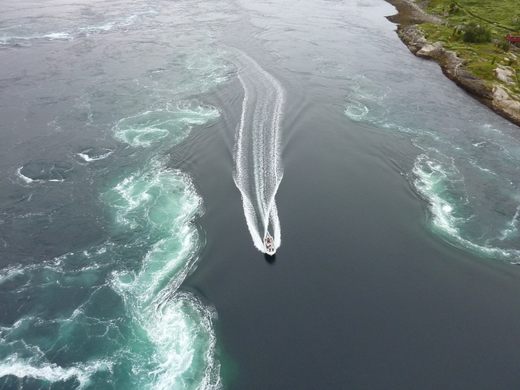Whirlpools are phenomena that form when water moving in two different directions comes into contact with each other and interacts unusually the most dangerous is called a Maelstrom. What is a Maelstrom?
A maelstrom is a powerful, turbulent whirlpool, characterized by intense swirling currents. Typically found in narrow straits, it results from the interaction of tidal forces, oceanic currents, and underwater topography, creating a visually striking unpredictable, and hazardous natural phenomenon.
Depending on the volume of water and the force of colliding waters, whirlpools can appear in different sizes. Some whirlpools form and disappear over a short period, while some water systems keep whirlpools for centuries.
Introduction:
In the vast lexicon of the English language, certain words capture the imagination and evoke vivid imagery, and ‘maelstrom’ is one such term. Conjuring thoughts of wild, swirling waters and chaos, the word has both a literal and metaphorical allure. But what exactly is a maelstrom? Is it merely a synonym for a whirlpool, or does it harbor a richer meaning? In this exploration of the term ‘maelstrom,’ we will dive into its definition, origins, and the various contexts in which it is used to enhance your understanding of this captivating concept.
What is a Maelstrom
A maelstrom is a powerful and turbulent whirlpool or vortex of water, typically with a large diameter and strong, swirling currents. These phenomena are often found in narrow straits or channels with significant tidal flows and complex underwater topography. Maelstroms can be caused by the interaction of tidal currents, underwater geography, and other oceanic dynamics.
The term “maelstrom” is derived from the Nordic words “mal” (grind) and “Strom” (stream), reflecting the grinding and churning motion of the water in these intense whirlpools. Maelstroms are known for their unpredictability and can pose navigational challenges for sailors due to their powerful currents and turbulent conditions.
One of the most famous maelstroms is the Moskstraumen, located off the coast of Norway. Maelstroms have also been the subject of myths, legends, and literary works, often portraying them as dangerous and awe-inspiring natural phenomena
Exploring the Maelstrom
What is a Maelstrom? It conjures up vivid images of chaos and tumultuous motion, often associated with seas and oceans. Originating from the Dutch and gaining prominence in English, the word maelstrom maps out a phenomenon that has piqued the curiosity of mariners, authors, and the public alike.
Turning to the dictionary for a clearer definition, one notes that a maelstrom, according to English lexicography, is not just an ordinary swirl of water.
A maelstrom is often described as vast and destructive, illustrating its capacity to engulf objects—or in a metaphorical sense—individuals, enterprises, or societies into its dizzying, uncontrollable spin. The gravity of this word in English parlance makes it a powerful descriptor, loaded with images of upheaval and intensity.
Maelstrom Whirlpools
Maelstrom whirlpools often occur in narrow straits, channels, or coastal areas with complex underwater topography. Locations with strong tidal flows, such as the meeting points of ocean currents, are particularly prone to the formation of maelstroms. Notable examples include the Moskstraumen off the coast of Norway, the Naruto Whirlpools in Japan, and the Corryvreckan in Scotland. These natural phenomena result from the intricate interplay of tidal forces, underwater geography, and oceanic dynamics, creating powerful and turbulent whirlpools.
Maelstrom Origins: Words and Grammer That Describes the Seas’ Powerful Phenomenon

A Maelstrom is a term that evokes the raw power and mystery of the sea. This word, with its origins deeply rooted in the marine lexicon, specifically refers to a large, powerful whirlpool within the sea or a marine channel.
- Maelstrom:
- Definition: A powerful, turbulent whirlpool, typically in the sea, characterized by strong tidal currents.
- Vortex:
- Definition: A mass of whirling fluid or air, especially a whirlpool or whirlwind.
- Turbulence:
- Definition: Irregular and unpredictable flow of fluid, often causing agitation and disturbance.
- Churn:
- Definition: Agitation or swirling motion, especially of water.
- Cyclone:
- Definition: A large-scale, atmospheric circulation system characterized by low-pressure centers and cyclonic flow.
- Eddy:
- Definition: A circular movement of water, counter to the main current, causing a small whirlpool.
- Swirl:
- Definition: A twisting or whirling motion, often in a circular pattern.
- Whirl:
- Definition: To spin or twist rapidly, creating a circular or spiral motion.
- Maelstrom Legends:
- Explore cultural and mythical narratives surrounding maelstroms in various societies, reflecting the awe and fear inspired by these natural phenomena.
- Oceanic Forces:
- Investigate the complex interactions between tidal forces, currents, and geographical features that give rise to maelstroms.
- Maritime Dynamics:
- Study the science behind the formation of whirlpools and the role of oceanic currents in creating these powerful phenomena.
- Tidal Phenomena:
- Examine the influence of tides on the manifestation of maelstroms, highlighting the intricate movement between gravitational forces and water movements.
Understanding the words and concepts associated with maelstroms provides insight into the dynamic and fascinating nature of these powerful whirlpools in the seas.
The concept of a Maelstrom has seeped into not just the vocabulary of sailors, but also into broader contexts where it’s used metaphorically to describe any situation where things appear to be in tumult or disarray, such as when an economy or government fails.
The term’s roots can be traced back to the Norwegian Sea where the actual phenomenon occurs, drawing in water with a strong tidal current that creates a swirling vortex powerful enough to be deemed a powerful whirlpool.
The power and unpredictability of a maelstrom have long been the subject of legends and tales—stories that have shaped our understanding of these natural marvels. People would heed warnings and sailor’s tales about where the sea raged the fiercest, often personifying these events to show respect for their potential wrath. Today, these swirling forces remain symbols of nature’s untamed spirit, a reminder that despite humanity’s progress and technological advantages, certain elements remain beyond our control.
These phenomena aren’t mere footnotes in tales of the sea; they’ve been critical in shaping maritime routes and the knowledge of navigators. The understanding of these whirlpools has been crucial for safe passage in certain marine channels, translating into direct implications for trade and the economy. Definitions and explanations are meritorious, but sailors of old—and even those today—know there’s a significant difference between reading about a maelstrom and experiencing one firsthand.
A look into the term ‘maelstrom’ gives us much more than a word; it offers a glimpse into maritime history, our relationship with the ocean, and how language evolves to encompass the indomitable forces of nature. So whether you’re engrossed in a novel depicting a dramatic sea voyage, listening to a seasoned sailor share spine-tingling stories, or simply aiming to bolster your own vocabulary and grammar skills, the term ‘maelstrom’ stands out as a powerful addition to any linguistic arsenal. The next time you read about these monstrous whirlpools, take a moment to appreciate the richness of the language and the history it carries with it.
Conclusion:
In summary, a maelstrom is a powerful whirlpool with a turbulent and potentially dangerous current. These mesmerizing yet fearsome natural phenomena have captivated human imagination for centuries, often embodying the raw power and unpredictability of nature. Understanding maelstroms not only satisfies human curiosity but also serves as a cautionary tale for those navigating the seas. As mariners of old respected and feared these mighty whirlpools, so must modern adventurers heed the lessons they impart about the respect due to our natural world.

References:
Interesting Engineering- Whirlpools 101:
Saltstraumen-The Worlds Strongest Maelstrom
FAQ’s
Q: What is a maelstrom?
A: A maelstrom is a large, powerful whirlpool within the sea or marine channel, known for its strong tidal currents that create a swirling vortex. It can be both a literal marine phenomenon and a metaphor for a chaotic or tumultuous situation.
Q: How did the term ‘maelstrom’ originate, and what does it mean in different contexts?
A: The term ‘maelstrom’ has Dutch origins and was traditionally used to describe a powerful sea whirlpool. In modern usage, it extends metaphorically to any disordered situation, such as a tumult in an economy or government.
Q: Can you explain the term ‘maelstrom’ using dictionary definitions?
A: Dictionaries describe a maelstrom as a vast and destructive whirlpool, highlighting its capability to engulf objects, individuals, or entities in its uncontrollable spin. Its application in English indicates upheaval and intensity.
Q: What is the significance of understanding the word ‘maelstrom’ in the English language?
A: Understanding the word ‘maelstrom’ is key to enhancing word knowledge in English. The term’s versatility in describing literal and figurative chaos showcases the language’s ability to capture diverse experiences.
Q: How has the concept of a maelstrom influenced language and culture?
A: The concept of a maelstrom has influenced not only maritime lexicons in French and German but also everyday language as a vivid description of tumult. It has also impacted legends, storytelling, and our understanding of marine navigation and nature’s untamed forces.




